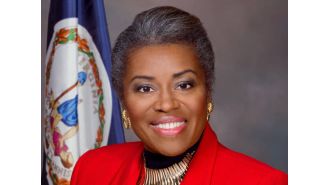We Asked Public Universities for Their Professors’ Conflicts of Interest — and Got the Runaround
We assembled the first state-by-state database of professors’ outside income and employment. But it’s far from complete.

Sharon Donovan and Richard Mattes have a lot in common. Both are full professors of nutrition science at leading public universities. Both sit on a federal advisory committee that helps craft the nation’s dietary guidelines. And both have extensive ties to the food industry.
That last similarity isn’t easy to uncover. Donovan, who teaches at the University of Illinois at Urbana-Champaign, has reported in required state filings that she received gifts, honoraria or consulting income from infant formula companies such as Wyeth Nutrition and Mead Johnson. The state makes her annual reports, and those of other University of Illinois employees, available to the public.
But the similar disclosure that Mattes is required to make to administrators at Purdue University in Indiana is confidential. Under Indiana law and Purdue policy, such conflict of interest reports are considered “personnel records” and therefore inaccessible. When ProPublica requested faculty filings from Purdue this year, our request was denied. Only by reading footnotes in specialized and sometimes expensive academic journals did we learn that in the past five years Mattes has consulted for or received research support from at least nine companies and trade groups, from Procter & Gamble and PepsiCo Global R&D to the Alliance for Potato Research and Education.
All too often, what’s publicly known about faculty members’ outside activities, even those that could influence their teaching, research or public policy views, depends on where they teach. Academic conflicts of interest elude scrutiny because transparency varies from one university and one state to the next. ProPublica discovered those inconsistencies over the past year as we sought faculty outside income forms from at least one public university in all 50 states.
About 20 state universities complied with our requests. The rest didn’t, often citing exemptions from public information laws for personnel records, or offering to provide the documents only if ProPublica first paid thousands of dollars. And even among those that released at least some records, there’s a wide range in what types of information are collected and disclosed, and whether faculty members actually fill out the forms as required. Then there’s the universe of private universities that aren’t subject to public records laws and don’t disclose professors’ potential conflicts at all. While researchers are supposed to acknowledge industry ties in scientific journals, those caveats generally don’t list compensation amounts.
We’ve accumulated by far the largest collection of university faculty staff conflict of interest reports available anywhere, with more than 29,000 disclosures from state schools, which you can see in our new Dollars for Profs database. But there are tens of thousands that we haven’t been able to get from other public universities, and countless more from private universities.
Sheldon Krimsky, a bioethics expert and professor of urban and environmental planning and policy at Tufts University, said that the fractured disclosure landscape deprives the public of key information for understanding potential bias in research. “Financial conflicts of interest influence outcomes,” he said. “Even if the researchers are honorable people, they don’t know how the interests affect their own research. Even honorable people can’t figure out why they have a predilection toward certain views. It’s because they internalize the values of people from whom they are getting funding, even if it’s not on the surface.”
In the 1970s, as discoveries in academia began to attract investment from industry, many universities grew concerned that such partnerships could create conflicts of interest for their faculty. By the 1980s and 1990s, some state universities started to limit how many days faculty could work outside of the university and how much they could earn by moonlighting. But they relied on the faculty to report their outside ties accurately.
“It was pro forma, letting the faculty do what they wanted as long as they taught their courses and did their duties,” said Arthur Caplan, a professor of bioethics at New York University School of Medicine. “It was up to the faculty to manage and make sure that [outside work] didn’t interfere with their contractual obligations.”
After the death of 18-year old Jesse Gelsinger during a gene therapy clinical trial at the University of Pennsylvania in 1999, many universities began to bolster the reporting and monitoring of conflicts. Dr. James Wilson, one of the trial’s main investigators, held shares in the biotech company that had the rights to the treatment, creating a potential conflict of interest. Although a disclaimer in the patient consent form disclosed his conflict, Gelsinger’s family sued the researcher and the university, settling the suit in 2000. Wilson did not respond to questions. Wilson learned from the experience, he later wrote, that “it is impossible to manage perceptions of conflicts of interest in the context of highly scrutinized clinical trials, particularly where there is a tragic outcome.”
Caplan was the director of bioethics at Penn at the time and advised on the early stages of the experiment. “The perception was that conflicts of interest led to poor management of the experiment,” he said. “That was one of the most pivotal events that drove forward the idea that universities have to be paying attention to conflicts.”
Most public and private universities require faculty to file reports on outside income and employment. If the university identifies a possible conflict, it may create a management plan for the professor to limit the potential for bias.
Even as universities — both public and private — have stepped up their internal reporting requirements over the past two decades, many public institutions have codified faculty disclosures as private information, making it almost impossible for the public to access the records.
More than a third of the nearly 30 state universities that rejected our public records requests cited personnel privacy laws, including Purdue. Zachary Baiel, president of the Indiana Coalition For Open Government, said that the state’s records laws leave room for interpretation because they don’t specifically address conflicts of interest. “Purdue is known for limiting access,” he said. Purdue University did not respond to ProPublica’s questions.
As a member of the Dietary Guidelines Advisory Committee, Mattes is required to report potential conflicts to the federal government, but those filings are also considered confidential. Without reviewing his journal articles, it would be very difficult to find out that he has received research support from, among others, Japanese food and biotechnology company Ajinomoto, the California Walnut Commission, the Almond Board of California and Welch Foods. He also has sat on the scientific boards of ConAgra and the Grain Foods Foundation, and he has consulted for ConAgra and life science clinical research company Biofortis.
Mattes told ProPublica that his research has often raised issues “that would be considered by many to be highly incompatible with a pro industry perspective,” such as salt in processed food and the physiological effects of low-calorie sweeteners. “The science is what matters, not who funded the work,” he wrote in an email. “I have a very easy test for avoiding conflicts of interest. If I would hesitate to speak my mind about the outcome of honest science, I don’t accept funding, engage in the work or publish the findings. Ethics starts with the individual, not the funding source.”
Another professor of nutrition science at Purdue, Regan Bailey, also sits on the dietary guidelines committee and has industry relationships that the university won’t reveal, though she disclosed some of them on her unofficial blog. A review of her recent work shows that, as of last year, she was a consultant for Nutrition Impact, a consulting group founded by former Kellogg’s executive Victor Fulgoni III, who conducts research for food and beverage companies. Bailey and Fulgoni have collaborated on a number of studies, including ones backed by the Sugar Association, Nestle and Barilla pasta. Fulgoni declined to respond to ProPublica’s questions. This year, Bailey also disclosed in a study on maternal health that she was a consultant for Nestle.
Since 2014, her research has received funding from the dietary supplement company Pharmavite, and she has served as a scientific adviser and government liaison for the ILSI North America Committee on Fortification, a food industry-backed nonprofit whose members include the Coca-Cola Co., DSM Nutritional Products, General Mills, the Kellogg Company, Nestle USA and PepsiCo Inc.
It’s standard practice in academia for nutrition professors to seek research funding from food companies. Of the 20 members of the dietary guidelines committee, nearly half — including Donovan, Mattes and Bailey — have had financial ties to industry over the past five years, either through research sponsorship or direct consulting or lobbying work.
Professors on the committee are supposed to make research-based recommendations on the intake of fats, beverages, added sugar and lactation to the U.S. departments of Agriculture and Health and Human Services, which then draft standards. Donovan, Mattes and Bailey, who were appointed this past February, are still reviewing research and won’t offer recommendations until 2020.
“The advisory committee has members who have not received any industry funding and members who have received a mix of both industry and non-industry funding,” said Jack Currie, a public affairs specialist for the USDA. “Funding sources were reviewed for awareness and to support balance across the committee.”
Currie added that the department’s ethics office reviewed committee members’ disclosures and found that all were in compliance with federal ethics rules. He declined ProPublica’s request for interviews with committee members. Donovan and Bailey declined to comment.
Concerns about the influence of industry have long plagued nutrition science, which historically has shaped the eating habits of everyday Americans. “The appearance of conflicts of interest is destructive of public trust,” said Marion Nestle, a professor of nutrition, food studies and public health at New York University, who served on the guidelines committee in 1995. “Those interests need to be disclosed at a minimum.”
The set of events behind Jesse Gelsinger’s death repeated itself five years later at the University of Minnesota. After a patient in a clinical trial there died in 2004, it was revealed that one of the principal investigators of the drug trial, Dr. Stephen Olson, had been paid by pharmaceutical company AstraZeneca, which had sponsored the research. Olson said the money went directly to the university, but did support his salary, according to local news reports. The patient’s mother sued the researcher and the university; the lawsuit ended in 2008 after a judge ruled the university had “statutory immunity” in such cases. The patient’s mother settled with the researcher for $75,000. An AstraZeneca spokesperson said the company’s relationships with health care professionals are appropriate and it complies with reporting requirements. Olson did not respond to questions from ProPublica.
Faculty members like Dr. Carl Elliott, a professor in the Center for Bioethics and the departments of pediatrics and philosophy at the University of Minnesota, pushed for greater transparency about conflicts of interest. While investigating the case, he requested faculty disclosures.
“In the aftermath of the scandal, the administration made a lot of public promises as far as reform goes,” Elliott said. “I was looking for information on industry-funded trials in the department of psychiatry, and the University of Minnesota stonewalled me on anything.”
The University of Minnesota also denied ProPublica’s records request, stating that the faculty reports were “private personnel data.” Don Gemberling, spokesman for the Minnesota Coalition on Government Information, who also helped draft portions of the state public data act, said the university’s lack of disclosure may stem from a fear of employee litigation.
“It’s reasonable from a risk management standpoint to say conflict of interest forms aren’t in the list of data that’s available to the public,” Gemberling said. “They treat them as private so they don’t get sued by their professors.”
The University of Nevada, Reno, also refused to provide copies of disclosures to ProPublica, calling them “confidential.” The university argued the public interest in the documents was outweighed by the university’s “need to foster full disclosure” by employees.
“Disclosing these documents publically (sic) would very likely chill employees from providing candid responses to these important questions and limit the University’s ability to fully evaluate potential conflicts of interest,” the university assistant general counsel, Megan Starich, wrote. The university said it would provide copies of the disclosure forms with “personally identifying information” removed for an estimated cost of $3,140.
A handful of other state institutions refused to supply records unless ProPublica paid thousands of dollars. To fulfill our request, the University of Florida said, would “take over 5,000 hours and consequently result in an extremely large (thousands of dollars) invoice for the estimated production cost, which must be paid in advance.”
Clemson University, a public land-grant institution in South Carolina, said it would release four years of conflict of interest and outside professional activity forms, but it estimated that it would cost ProPublica more than $4,000. After we narrowed our request to the most recent year of data, the university estimated its bill would still be close to $3,000. Similarly, the University of Michigan estimated its price at $2,170, half to be paid in advance. ProPublica chose not to pay Clemson or Michigan.
“It’s a significant problem to have fees of thousands and thousands of dollars,” said Jennifer Nelson, a staff attorney for the Reporters Committee for Freedom of the Press, who added that unaffordable fees can be a deterrent for all citizens, not just reporters. “It defeats the whole purpose of having a records law in the first place.”
The University of Massachusetts flagship campus in Amherst initially informed ProPublica it would provide disclosure of financial interest forms filed by employees since 2016 for a fee of $1,025. After ProPublica paid it, the university decided not to release the documents, claiming they were exempt personnel records. The university returned ProPublica’s check.
New York balked for another reason. The state’s Joint Commission on Public Ethics, which collects the financial disclosures filed by more than 5,000 employees of the state university system, said it would provide forms for individual employees when requested by name, but it would not release its entire database. That “would be a prohibitive task for the Commission given the very small number of staff members who work to fulfill the record requests we receive,” it wrote.
Other states withheld critical portions of disclosure records, such as compensation amounts or the names of outside employers. The University of Alaska provided ProPublica with the names of faculty members who filled out the conflict of interest reports but no other information.
“The data fields you mentioned like title, outside interest, type of activity and compensation type of information are not stored in the database and is not available during the extraction,” said Shiva Hullavarad, a data privacy and compliance officer for the University of Alaska. Hullavarad did offer to provide ProPublica with information on specific employees on request.
Some state universities that refused to provide their own disclosure forms did turn over data related to federally funded research. For instance, when professors apply for or receive grants from the National Institutes of Health, they frequently submit conflict of interest reports to their universities, which send the information to NIH. The schools must disclose this information to the public under federal law. Ultimately, we didn’t have to collect these forms from each institution because NIH shared its database with us.
These records, though, only account for a small fraction of the faculty with potential conflicts. For example, the University of Hawaii, which has nearly 1,000 faculty members, provided ProPublica with fewer than 10 disclosures related to federally funded research. The university denied ProPublica more disclosures, citing a “significant privacy interest.”
At private universities, which aren’t subject to public records laws, we found out about conflicts of interest for professors through their journal articles or disclosures for NIH funding. Dr. Jamy Ard, a professor of epidemiology and prevention at private Wake Forest University and a member of the advisory committee on dietary guidelines, disclosed in recent journal articles that he has consulted for Nestle, Amgen, Boehringer Ingelheim, Novo Nordisk and Eisai and received research support from both Nestle and pharmaceutical company VIVUS. In NIH filings, Ard was listed as a consulting medical director for Optifast, a weight loss program from Nestle. Ard and Wake Forest did not respond to emailed questions.
Several of the largest and most prestigious state higher education systems have some of the most stringent rules and best public access to records.
California has multiple layers of conflict of interest and outside employment reporting, and all disclosures are considered public records. We received nearly 2,600 forms from all 10 of the University of California’s campuses, documenting the payments that faculty received from the private and public sponsors of their research.
The secretary of state of Illinois requires all state employees, including faculty at public universities, to file forms documenting outside work or personal financial interests, such as stocks or real estate. The forms are available to the public in a searchable database, and we have included more than 12,250 Illinois records in Dollars for Profs. However, the forms don’t require state employees to report how much they’re paid by industry.
The University of Texas System does collect the amount of outside compensation, but excised it from the more than 6,200 disclosures given to us. It contended that compensation amounts are private. Seeking the financial information, ProPublica appealed to the state attorney general’s office. It sided with the university.






